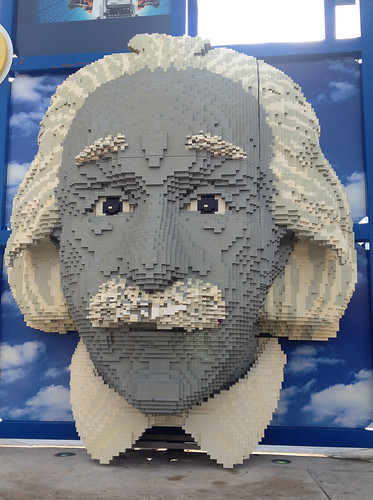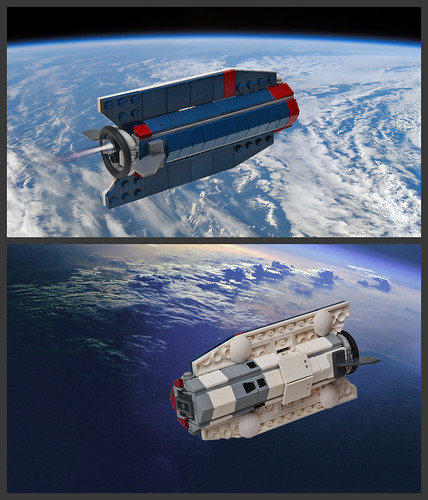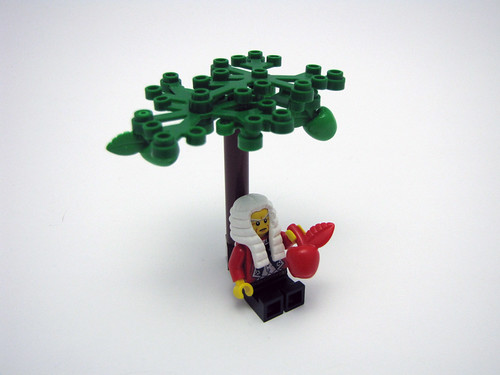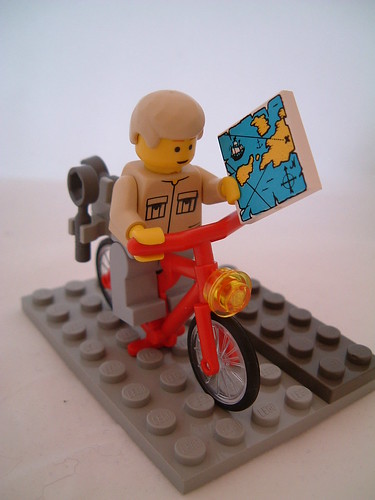
Showing posts with label physics. Show all posts
Showing posts with label physics. Show all posts
Thursday, August 27, 2015
Waveform
Light and sound can be described as waves traveling through some medium. A simple wave can take an easily described form such as a sine function, but if you put a bunch of waves together, such as a burst of many wavelengths of light or a musical chord, the waves add together in constructive and destructive ways to get a much more complex waveform, such as this shown by Matt De Lanoy. I wonder if you can perform a fourier transform on a stack of LEGO elements.


Thursday, March 19, 2015
Stepping on a LEGO
Karl Smallwood of Today I Found Out investigated Why Does Stepping On A LEGO Hurt so Much? He starts by noting that the soles of the feet are highly sensitive, which helps us balance, and then he analyzes how much force stepping on a LEGO leads to. Here are the key paragraphs:
To illustrate, here's a cartoon by ILoveDoodle.

For an example, a standard 2×2 Lego brick has a surface area of roughly 2.25 centimetres squared (for the sake of simplicity we’ll ignore the studs, which certainly aren’t going to help matters for your foot anyway). Let’s say a person weighing 75 kilos (165 pounds or 734 Newtons) steps onto it.
Now, the pressure on a given object is equal to the force applied divided by the area over which it is spread (P=F/A). So even if that 75 kilo person were just standing on the Lego with one foot, rather than having their foot accelerating downward at some rate as with walking, this gives us 734 N/0.000225 m2 = roughly 3,262,222 pascals of pressure! For reference, that is roughly 32 times standard atmospheric pressure, all suddenly forcing its knobbly, unforgiving way against one of the most sensitive regions of the body.
To illustrate, here's a cartoon by ILoveDoodle.

Tuesday, March 17, 2015
Albert Einstein
In addition to being Pi Day, March 14 is also Albert Einstein's birthday. Einstein is easily the most recognizable scientist of the 20th century. His theory of relativity helped move us from Newtonian physics into the modern era. He received the 1921 Nobel in physics for his work on the photoelectric effect, but more broadly on all of his work in physics. He helped start the Manhattan Project by signing a letter to President Roosevelt about the potentially devastating nature of atomic bombs. Since he is such a key figure, and also so recognizable, he has been the inspiration for a great number of LEGO renditions. Here are just a handful of ones I found.
This mosaic (by who?) was on display at BrickWorld this past weekend.

Arthur and Laura Sigg built this mosaic.

Here's a miniland version by Annie1.

This huge sculpture is found in Legoland Florida (and there are similar sculptures at other Legolands as well).

There are tons of other LEGO Einsteins out there, but I'll save them for another time. Maybe next year's birthday.
This mosaic (by who?) was on display at BrickWorld this past weekend.

Arthur and Laura Sigg built this mosaic.

Here's a miniland version by Annie1.

This huge sculpture is found in Legoland Florida (and there are similar sculptures at other Legolands as well).

There are tons of other LEGO Einsteins out there, but I'll save them for another time. Maybe next year's birthday.
Wednesday, December 17, 2014
GOCE
The Gravity Field and Steady-State Ocean Circulation Explorer, or GOCE, (here in LEGO by Stefan Schindler) was a low-earth-orbit satellite operated by the European Space Agency from 2009-2013 to map out the earth's gravitational field, and also to probe the structure of the earth's mantle, with some focus on volcanic regions, and study oceanic behavior.


Friday, December 12, 2014
Particle accelerator
A particle accelerator is a large (often miles in circumference) track that accelerates charged particles to very high speeds using a series of electromagnetic fields. In a collider the fast-moving particle then slams into a target, and physicists watch how it falls apart to learn more about the fundamental nature of subatomic particles. Jason Alleman built this one out of LEGO; be sure to watch the video to see it in action.


Wednesday, December 10, 2014
Planck's Constant
Planck's constant is one of the fundamental constants of the universe. E=hν is an equation relating the energy of light (E) to the frequency of light (ν), where h is Planck's constant. You can measure this constant in a number of ways, including the use of a watt balance. A watt balance measures the difference between the gravitational pull on an object and the the force pulling on that object by a magnetic field produced by an electromagnet. Since the calculation of the force of the electromagnet includes Planck's constant, the data can be deconvoluted to solve for h. Leon Chao and colleagues at the National Institute of Standards and Technology have designed a LEGO watt balance. BTW, for the last 139 years the kilogram has been officially defined by a chunk of metal stored in a vault in France. At recent meetings of the International Committee for Weights and Measures (sounds like a fun group) they have discussed changing the official definition of the kilogram to one based on Planck's constant by the use of a watt balance.
Fun new fact for me - metrology is the science of measurement. I didn't know that one until reading up on the use of the watt balance.

Fun new fact for me - metrology is the science of measurement. I didn't know that one until reading up on the use of the watt balance.

Monday, December 8, 2014
Northern lights
Hi all,
First up, I just wanted to apologize for my six month hiatus. I've been blogging about LEGO for nine years now, and from time to time I've just gotten a bit run down and distracted from my family of blogs. However, in the meantime, I'm constantly going through Flickr, Brickshelf, and other sites, and probably every day I bookmark a few more things that I keep meaning to post. I've gotten a couple of nice notes asking where I've been, and I guess it's time to come back. Also, during the year I save up LEGO books to review as people are getting ready for Christmas, and want to get those posted. And so, back to blogging. Hopefully I won't have too many interruptions in the near future. I've certainly got a backlog of great creations to feature.
The northern lights, or Aurora borealis, are depicted in this mosaic by Dave Ware. This light show actually starts at the sun. Extremely high temperature, and therefore high energy, collisions between particles result in naked protons and electrons being flung from the sun's surface. When this 'solar wind' hits the earth, the earth's magnetic field either deflects the particles or funnels them down towards the earth's surface at the north and south poles. As these high energy particles encounter the gases of our atmosphere, energy is given off in the form of light.

First up, I just wanted to apologize for my six month hiatus. I've been blogging about LEGO for nine years now, and from time to time I've just gotten a bit run down and distracted from my family of blogs. However, in the meantime, I'm constantly going through Flickr, Brickshelf, and other sites, and probably every day I bookmark a few more things that I keep meaning to post. I've gotten a couple of nice notes asking where I've been, and I guess it's time to come back. Also, during the year I save up LEGO books to review as people are getting ready for Christmas, and want to get those posted. And so, back to blogging. Hopefully I won't have too many interruptions in the near future. I've certainly got a backlog of great creations to feature.
The northern lights, or Aurora borealis, are depicted in this mosaic by Dave Ware. This light show actually starts at the sun. Extremely high temperature, and therefore high energy, collisions between particles result in naked protons and electrons being flung from the sun's surface. When this 'solar wind' hits the earth, the earth's magnetic field either deflects the particles or funnels them down towards the earth's surface at the north and south poles. As these high energy particles encounter the gases of our atmosphere, energy is given off in the form of light.

Monday, April 14, 2014
Magdeburg hemispheres
Otto von Guericke, a German scientist and also the mayor of Magdeburg, invented a vacuum pump and studied the effects of vacuum and air pressure. In one of his most spectacular experiments, he fit two copper hemispheres together and used his pump to create a vacuum inside. This created a force holding the hemispheres together that was so great, teams of horses could not pull them apart until the valve was opened and air was let back inside. This experiment was illustrated here by Tim v.F. for the New Scientist LEGO contest.


Friday, January 17, 2014
Newton's apple
I was told once in a class that the whole story of Newton and the apple was a myth invented many years later, but some quick Googling found this memoir by William Stukeley, a friend and biographer of Newton, who recounts the story. The apple didn't hit him on the head, as sometimes shown in cartoons, but Newton was walking in the garden thinking about why apples always fall straight down, rather than at some angle, and he came up with his first formulation of the law of gravity. Here is Chris Maddison's LEGO rendition.


Tuesday, October 8, 2013
Physics prize!
Alright, after leaving a few hours for the medicine and physiology to have the top position here, it's time to celebrate the 2013 Physics Nobel, awarded to François Englert and Peter W. Higgs, for their work on the Higgs boson going back fifty years. They developed a theory that unified the weak interaction and electromagnetism and helps explain the Standard Theory of matter. One prediction of their theory was the Higgs boson, which was first observed experimentally about a year ago and confirmed earlier this year. These experiments were performed at CERN, in part using the ATLAS detector, here in LEGO form by Dr. Sascha Hehlhase.

So, anyone want to take bets on the Chemistry prize? I'll be following #nobel on Twitter early tomorrow morning to get the announcement because, yes, I'm that big a geek.

So, anyone want to take bets on the Chemistry prize? I'll be following #nobel on Twitter early tomorrow morning to get the announcement because, yes, I'm that big a geek.
Wednesday, September 18, 2013
Foucault's Pendulum
Today's Google doodle celebrates the 194th anniversary of Léon Foucault's birth. Foucault was a French physicist who did work on such areas as magnetism and momentum, but his two most notable accomplishments were an early measure of the speed of light, and his pendulum demonstrating the rotation of the Earth. Imagine a pendulum hanging over a turntable. If you start the pendulum swinging, it will go back and forth in a straight line. If you start the turntable spinning, an ant on the turntable would see the pendulum doing loops from his perspective. If you attached traced out the route of the swinging pendulum on the spinning turntable, you'd get a design something like the Spirograph art I remember from when I was a kid. Foucalt found that with freely swinging pendulum with a long enough arm, you could actually see the effect of the spinning planet. This effect is strongest at the north and south pole, and disappears at the equator - so you can use the magnitude of the effect to determine your latitude.


Monday, August 12, 2013
Schrödinger's cat
Today's Google doodle remembers Erwin Schrödinger, one of the key figures in the development of quantum mechanics and winner of the 1933 physics Nobel. In my day job I'm a computational chemist, and my work largely depends on using computer models that approximate Schrödinger's equation that is used to describe the arrangement of electrons in molecules. In the popular eye he is remembered for his "Schrödinger's cat" thought experiment. He was critical of a particular interpretation of quantum mechanics that says that for certain phenomena that could equally exist in two different states, say, for instance, the spin of an electron, the resolution of the two states is dependent on an observer - that is, until someone measures it, the electron equally exists in both states. In his argument, he asked us to imagine a cat in a box. Somehow, the release of a poison is rigged to the decay of a radioactive atom. Since it is impossible to predict whether the atom will decay or not until it is observed, under the Copenhagen interpretation of quantum mechanics, the cat is both dead and alive until you open the box. I think most people actually misinterpret his point. He wasn't actually saying the cat is both dead and alive simultaneously, instead it was a reductio ad absurdum argument, showing how the Copenhagen interpretation can to obviously ridiculous conclusions.
For our LEGO illustration, here is a two-sided scene by Sea Serpent. On one side the scientist (Schrödinger, presumably) opens the box to hug his cat, on the other side he is distressed to find his cat is dead.



For our LEGO illustration, here is a two-sided scene by Sea Serpent. On one side the scientist (Schrödinger, presumably) opens the box to hug his cat, on the other side he is distressed to find his cat is dead.



Monday, July 29, 2013
Atlas Detector
I've previously noted Dr. Sascha Hehlhase's LEGO rendition of the Atlas detector, used in the search for the Higgs boson. He's gone on and made a Cuusoo project of the Atlas detector, which subsequently received 10,000 votes. I seriously doubt this will become an official LEGO set, but it would be cool if kids all over were asking their parents to buy them a LEGO Atlas detector.


Friday, June 28, 2013
Synchrotron
The Canadian Light Source is a national research center located at the University of Saskatchewan. They pursue research using a synchrotron. This is a type of cyclic particle accelerator that accelerates electrons to speeds approaching the speed of light. This leads to extremely powerful beams of light that can be tuned to any desired wavelength. CLS scientist built this end station. As I understand from their description, the beam of light coming off the synchrotron enters the optics hutch, the white bit that takes up about 2/3 of the right portion of this model, via that gray nozzle on the right side. Inside the optics hutch, the beam is focused and tuned to the desired wavelength. The resulting narrow beam leaves the optics hutch and hits the experimental hutch, the white bit on the left hand side of this photo. There scientists study how the light energy affects or interacts with some sample they are interested in.


Monday, May 20, 2013
Newton's cradle
I've previously described a Newton's cradle, a desktop toy that demonstrates the conservation of momentum. Derfel Cadarn has built another LEGO version.


Friday, March 1, 2013
Thursday, December 20, 2012
Book Review: Unofficial LEGO Technic Builder's Guide
Next up in my series of book reviews as last minute presents for the AFOL in your life. I'm posting this same book review across most of my blogs, but I'm adding some blog-specific content at the end of each posting.
Unofficial LEGO Technic Builder's Guide by Paweł “Sariel” Kmieć, 2013, No Starch Press

On the one hand I might not be the right person to review this book. Even though I have fond memories of my best friend getting what must have been set 956 oh so many years ago, and at one point I got the Technic Jango Fett as part of a large eBay Star Wars LEGO lot, about the only thing I regularly do with Technic elements is put a small gear on a rod to make a mace for my castle minifigs. On the other hand, I'm pretty much the perfect market for this book, which is well situated for the builder who is fairly competent with LEGO building but has no real experience with Technic. That said, even the expert Technic builder would surely find this to be an extremely useful book. The author, Paweł “Sariel” Kmieć, is a well-known Technic builder. He's active in LUGPol and contributes to various Technic or NXT themed sites. You're quite likely to have seen some of his amazing MOCs on the Brothers Brick or other community sites, and you can find them all on his own site, Sariel.pl. Eric "Blakbird" Albrecht of Blakbird's Technicopedia is listed as a tech reviewer and advisor, and he may have helped with the illustrations, though that is not made clear.

This book is a beautiful intro to Technic building. Almost every page is full of full color illustrations - some photos, but mostly LDRAW - that clearly illustrate the topics under consideration. Without a lot of fluff intro, Paweł jumps straight into a discussion of the basics of Technic building. He starts out with a quick introduction to concepts of physics and mechanics that underlie the complex creations, goes through a comprehensive discussion of different Technic elements and how they work, and by the end of the book works you through intricate mechanisms, such as a ten-speed synchronized transmission, or a heavy-duty pendular portal axle. The complete Table of Contents can be seen here. The writing style is very clear, so you don't have to start out as an expert car mechanic to enjoy this book (believe me - I barely know how to check my oil). Along the way Paweł includes a ton of information. For instance, he goes through every type of gear and shows how they work, or in another chapter he gives a complete description of the advantages and disadvantages of every LEGO motor.

There are a couple of things that are not in this book. There is virtually nothing about Mindstorms or Mindstorms NXT, which are often grouped in with other Technic building. I actually don't think that's a failing, as to try and fit in a lot about programming and robotics would have necessarily led to a watering down of the content that is in this book. Also, No Starch has several other Mindstorms NXT books, which makes me think that this is part of a strategic plan to make a library of great reference works. The other thing that this book is not about is finished models. Yes, Paweł has a ton of photos of beautiful finished trucks, tanks, cranes and other models to inspire you, but he's not out to provide step-by-step instructions to make these. Instead he gives you step-by-step instructions to make the drive train, or steering mechanism, or other mechanics 'under the skin'. You can then build your own skin on top of this solid skeleton. Again, other No Starch offerings, such as these Technic Idea Books might be good to explore as a next step.

I would highly, highly, highly recommend this book (highly even) for anyone above the very introductory level builder. If you've never made a Technic model before but want to try, Paweł clearly teaches you from the ground up. If you're an expert Technic builder, you'll benefit from the comprehensive listings of different parts, and be able to adapt the complex mechanisms Paweł describes. Even if you've never had an interest in Technic, and those funny beams and half pins that occasionally show up in your System sets make their way into your 'useless parts bin' only to show up as an occasional greeble, you'll be inspired by this. Now I want to go dig into my own bin and pull out some gears and axles to play with!

SciBricks-specific content This book goes through the basics of simple mechanics, describing things like different types of levers, gear ratios, pulleys, how speed and torque relate to power, etc.
Unofficial LEGO Technic Builder's Guide by Paweł “Sariel” Kmieć, 2013, No Starch Press

On the one hand I might not be the right person to review this book. Even though I have fond memories of my best friend getting what must have been set 956 oh so many years ago, and at one point I got the Technic Jango Fett as part of a large eBay Star Wars LEGO lot, about the only thing I regularly do with Technic elements is put a small gear on a rod to make a mace for my castle minifigs. On the other hand, I'm pretty much the perfect market for this book, which is well situated for the builder who is fairly competent with LEGO building but has no real experience with Technic. That said, even the expert Technic builder would surely find this to be an extremely useful book. The author, Paweł “Sariel” Kmieć, is a well-known Technic builder. He's active in LUGPol and contributes to various Technic or NXT themed sites. You're quite likely to have seen some of his amazing MOCs on the Brothers Brick or other community sites, and you can find them all on his own site, Sariel.pl. Eric "Blakbird" Albrecht of Blakbird's Technicopedia is listed as a tech reviewer and advisor, and he may have helped with the illustrations, though that is not made clear.

This book is a beautiful intro to Technic building. Almost every page is full of full color illustrations - some photos, but mostly LDRAW - that clearly illustrate the topics under consideration. Without a lot of fluff intro, Paweł jumps straight into a discussion of the basics of Technic building. He starts out with a quick introduction to concepts of physics and mechanics that underlie the complex creations, goes through a comprehensive discussion of different Technic elements and how they work, and by the end of the book works you through intricate mechanisms, such as a ten-speed synchronized transmission, or a heavy-duty pendular portal axle. The complete Table of Contents can be seen here. The writing style is very clear, so you don't have to start out as an expert car mechanic to enjoy this book (believe me - I barely know how to check my oil). Along the way Paweł includes a ton of information. For instance, he goes through every type of gear and shows how they work, or in another chapter he gives a complete description of the advantages and disadvantages of every LEGO motor.

There are a couple of things that are not in this book. There is virtually nothing about Mindstorms or Mindstorms NXT, which are often grouped in with other Technic building. I actually don't think that's a failing, as to try and fit in a lot about programming and robotics would have necessarily led to a watering down of the content that is in this book. Also, No Starch has several other Mindstorms NXT books, which makes me think that this is part of a strategic plan to make a library of great reference works. The other thing that this book is not about is finished models. Yes, Paweł has a ton of photos of beautiful finished trucks, tanks, cranes and other models to inspire you, but he's not out to provide step-by-step instructions to make these. Instead he gives you step-by-step instructions to make the drive train, or steering mechanism, or other mechanics 'under the skin'. You can then build your own skin on top of this solid skeleton. Again, other No Starch offerings, such as these Technic Idea Books might be good to explore as a next step.

I would highly, highly, highly recommend this book (highly even) for anyone above the very introductory level builder. If you've never made a Technic model before but want to try, Paweł clearly teaches you from the ground up. If you're an expert Technic builder, you'll benefit from the comprehensive listings of different parts, and be able to adapt the complex mechanisms Paweł describes. Even if you've never had an interest in Technic, and those funny beams and half pins that occasionally show up in your System sets make their way into your 'useless parts bin' only to show up as an occasional greeble, you'll be inspired by this. Now I want to go dig into my own bin and pull out some gears and axles to play with!

SciBricks-specific content This book goes through the basics of simple mechanics, describing things like different types of levers, gear ratios, pulleys, how speed and torque relate to power, etc.
Sunday, November 18, 2012
Certain?
Werner Heisenberg Knows Where He Is, But Is Uncertain As To How Fast He Is Going, by Kaptain Kobold.
The Heisenberg Uncertainty Principle holds that the better you know the location of a particle, the less you know the momentum, and vice versa. This understanding helped form the foundation for quantum mechanics.

The Heisenberg Uncertainty Principle holds that the better you know the location of a particle, the less you know the momentum, and vice versa. This understanding helped form the foundation for quantum mechanics.

Thursday, October 25, 2012
Newton vs the apple
Newton famously contemplated gravity when watching an apple fall from a tree (not actually hitting him on the head, as seen here in LEGO by Brother Steven).

... why should that apple always descend perpendicularly to the ground ... [he described is thoughts in a later conversation] ... why should it not go sideways, or upwards? but constantly to the earths centre? assuredly, the reason is, that the earth draws it. there must be a drawing power in matter. & the sum of the drawing power in the matter of the earth must be in the earths centre, not in any side of the earth. therefore dos this apple fall perpendicularly, or toward the centre. if matter thus draws matter; it must be in proportion of its quantity. therefore the apple draws the earth, as well as the earth draws the apple.

Monday, October 15, 2012
Q is for quantum
Q is for quantum: Physics The smallest amount of a physical quantity that can exist independently - by Lamont Cranston. Serge Haroche and David Wineland shared the 2012 Nobel Prize in Physics for their work on studying individual quanta. Haroche devised a method for slowing down and examining photons, the smallest bits of light. Wineland found a way to trap individual ions (charged atoms) for study.


Subscribe to:
Posts (Atom)
